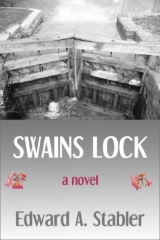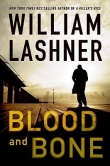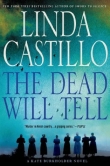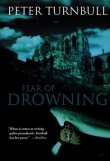
Текст книги "Swains Lock"
Автор книги: Edward A. Stabler
Жанры:
Триллеры
,сообщить о нарушении
Текущая страница: 5 (всего у книги 25 страниц)
“Eels, cool!”
“And the canal flows, too. It was designed to flow at two miles per hour. Why do you think they designed it that way?” More people peeled away, but the few remaining were listening again. Nicky nudged Vin with her elbow and rolled her eyes, but he put a hand on her shoulder and focused on the ranger.
“I don’t know,” the boy said.
“To help the mules?” Vin said, making eye contact with the ranger.
The ranger brightened. “That’s right! With the canal set to flow at two miles per hour, it was the same amount of effort for the mules to pull a loaded boat downstream or a light boat upstream.”
“But the canal is flat,” the boy said. “What makes it flow?”
“The same thing that makes a fountain flow,” the ranger said. “Actually, the canal is like a fountain that’s a hundred and eighty-four miles long, and made up of seventy-four connected levels stretched end to end. The water flows into the fountain from the Potomac River, through five separate feeder canals that draw water from the river. The feeder canals have gates like these,” he said, pointing once more to the lock gates, “called guard locks. Once the water is in the canal, it flows continuously across each level at two miles per hour, and then cascades down to the next level using one of two routes: the lock or the flume.
“You already know how the lock transfers a boat and water downstream. But when the lock isn’t being used, it acts like a dam, so water flows through the flume to drop from one level of the canal down to the next. Some flumes are just a straight channel parallel to the lock that leads to a seven-foot waterfall into the lower level. Other flumes are rocky streams that curve around the lockhouse. These flumes take an indirect path to make the descent more gradual.”
“I think we need to take an indirect path out of here,” Nicky whispered, ducking her shoulder out from under Vin’s hand. “This guy could go on forever!” Vin smiled but kept his eyes on the ranger.
“And after the water had flowed down to the lowest level of the fountain, it was used to power the grain mills in Georgetown.”
“So that was part of the business of the canal?” Vin said. “Selling hydro power?” Nicky exhaled loudly and waggled her head in apparent disbelief.
“Sure was,” the ranger said. “Even when other parts of the canal were closed due to flood damage, they tried to keep the Georgetown feeder canal open to provide power to the mills.” The remainder of the group used Vin’s question as a chance to escape, leaving Vin and Nicky alone with the ranger.
“Actually,” the officer continued in a quieter voice, looking at them in turn, “all the feeder canals were important, since the canal was quite thirsty.”
“I’m thirsty, too,” Nicky said, “and I forgot to bring my water bottle. Did I see a water fountain near the Visitor Center?”
“There’s one near the front entrance,” the ranger said, pointing toward the facade.
Vin shot a glance at Nicky. “I’ll meet you over there in a second,” he said as she turned to walk her bike toward the entrance.
“Thirsty?” Vin said. “You mean evaporation, or leaks?”
“Both. Water evaporated from the surface in dry weather. And muskrats would burrow into the banks and cause leaks. Sometimes they’d undermine the bank enough to cause a break. The water would blow through the break and run down into a culvert, or toward the river, and the whole level would drain. Any boats on that level would be stranded.”
Vin nodded. “That sounds like a big problem.”
“Dangerous, too,” the ranger said, “if you were driving mules out on the towpath at night. They’d send a repair crew out in the middle of the night if there was a break. Of course, after a heavy rain, the canal might have too much water.”
“I guess that makes sense,” Vin said, looking back in the direction Nicky had gone.
“When that happened, they’d open the gates to the waste weirs.”
“Waste weirs?”
“Waste weirs are channels that drain excess water from the canal down to the river. They use gates with miniature paddles to shunt the water through culverts under the towpath. There’s one just above this lock.”
“Speaking of towpath,” Vin said, “I need to catch up with my fiancée and hit the trail. Thanks for the presentation.”
“You bet,” the ranger said. He raised the brim of his hat and looked back at the barge, which a young couple and their small children were admiring. “Excuse me,” he said, turning in their direction.
Vin found Nicky waiting on the brick walkway near the entrance to the Visitor Center.
“That was kind of scary,” she said. “I was worried he was going to drag you back to the barge to show you how the mules were hooked up, or start telling you what the boat captains ate for breakfast.”
“I guess we missed that part of the program. Maybe we should come back next Saturday… get here a little earlier…”
“Be my guest. Maybe you can learn the material and be his assistant.”
“I wonder if he knows anything about Lee Fisher. Or Emmert Reed. Hmmm…maybe I could write a book about all this canal stuff.”
“You could call it Life at Two Miles per Hour,” Nicky said. “Or how about, I Was a Teenage Mule Driver.”
***
After examining the photo of Lee Fisher and K. Elgin for several minutes, Kelsey carefully laid it back on top of Lee’s note on the breakfast-nook table, then walked downstairs and slipped out the sliding door. As she crossed under the deck, Randy rushed to the railing and serenaded her with another threatening round of barks. She ignored him and traversed the lawn toward the hillside, where she found the path and disappeared into the woods.
***
Pedaling the five-plus miles back to Pennyfield Lock, Nicky fell in behind Vin. The tourist traffic thinned out a mile above Great Falls and Vin tried to visualize what the canal must have looked like while it was still operating. Mule teams moving steadily down the towpath and barges gliding silently around the bends, day and night. How long ago was that? He thought the ranger had said the C&O shut down in 1924. That was the year written on Lee Fisher’s photo! Or had he heard incorrectly?
Two miles along, he saw the whitewashed stone lockhouse at Swains emerge on the berm side of the canal. He let his bike decelerate up the incline beside the lock.
“Let’s stop for a second, honey.”
“At the scene of your latest dog-fight?” Nicky dismounted and bent to stretch her lower back as Vin laid his bike down. The downstream gate was open, set flush into the lock wall, so its swing-beam ran parallel to and above the wall. He tried to push the end of the beam toward the towpath to close the gate. It moved an inch and stopped. He noticed a thin wire cable connecting the swing-beam to its counterpart across the lock. Since the wire was taut and the beams were designed to swing in opposing directions, neither beam could move. When he pushed the beam again, the cable transferred his effort to the beam across the lock.
Nicky had finished stretching and walked over to him with her bike. She ran its front tire slowly over his foot. “Hey Inspector Clouseau – tell me this is a temporary obsession.”
He extracted his foot. “I was just admiring the construction. This lock is like Lock 20; it’s still in good shape. The lock-keys are missing, but the original iron stems and hinge collars are all intact.” He pointed at the upstream face of the swing-beam. “There’s the old iron stirrup bracket that must have been used to support the block that held the crossing plank. I guess they took the planks away on the downstream gates.” He surveyed the lock walls. “And look at the red stone bricks they used to build the lock. Imagine how much work it must have been to hand-cut all of these stones.”
“OK, that’s the end of today’s history lesson. You can write it up for your social-studies teacher. Let’s keep moving.”
They pedaled upstream toward Pennyfield, passing a scattering of Swains-based dog-walkers and joggers en route, and Vin’s thoughts drifted to the next set of tasks on his project for Rottweiler. If he got some comments back by Monday or Tuesday, he could start designing the database by mid-week. Otherwise he’d have to spend the week reading programming books and playing with sample code. He kept his eyes on the towpath and didn’t notice as they passed a slender woman wearing dark glasses and a canvas jacket and walking back toward Swains.
“Hey,” Nicky said as they passed the woman. “Wasn’t that your victim?”
“What?” He looked back to hear her better.
“From last weekend. Your mysterious photographer friend.”
Chapter 6
Books
Wednesday, November 15, 1995
Vin walked into the Potomac Library for the first time. It was small but inviting, with a perimeter of stacks surrounding circular reading tables and half-height reference shelves in the center of the room. A librarian at the information desk guided him to a shelf devoted to Maryland geography and history, a portion of which held books about the Chesapeake and Ohio Canal. After thumbing the relevant titles, he carried four books to a cubicle on the far wall.
Sunlight slanting through tinted windows warmed his shoulders as he placed a notepad and pencil on the cubicle desk. He jotted down the names of the authors and leaned back to open the first book, Walter Sanderlin’s The Great National Project: A History of the Chesapeake and Ohio Canal. The 1946 book chronicled the history of the canal’s construction, operation, financial troubles, and demise in densely-footnoted detail, beginning with the chartering of the Ohio Company in 1749 in an attempt to develop a trade route connecting the Ohio River territory with Washington and Baltimore via the Potomac River valley.
He set it aside and opened A Towpath Guide to the Chesapeake and Ohio Canal by Thomas F. Hahn, which offered a terse mile-by-mile discussion of the architecture, history, topography, and ecology of the C&O Canal, from Georgetown to Cumberland. The pages covering locks 21 and 22 provided structural details on the locks and lockhouses at Swains and Pennyfield, but no information about the 1920s denizens of those lockhouses.
Another Hahn book, The Chesapeake and Ohio Canal: Pathway to the Nation’s Capital, seemed more promising. He skimmed an entertaining account by an itinerant New Englander of his experience as a novice boathand on a coal barge during a trip from Cumberland to Georgetown and back in 1859. And he found descriptions of 19th-century canal characters, along with recollections and anecdotes from aging boatmen that Hahn had interviewed in the 1960s and 1970s. Getting closer to the mark, he thought. By now he had memorized Lee Fisher’s note, so he knew what names to look for. He turned to the index listings under R.
Renner. Rumsey. No Reed. No Elgin or Fisher in the index either, and no reference to Swains Lock, but four listings under Swain. Based on the remarks attributed to them in the text, he was confident that Clifford and John Swain were boatmen. Mamie Swain seemed to be a boater’s wife and Otho Swain’s occupation wasn’t specified, though he was quoted on the superiority of mules to horses for canal work. Vin was sure that one or more of those Swains had inspired the colloquial name for Lock 21. And if that were true, maybe the Hahn book had a relevant listing under Pennyfield, the name associated with Lock 22.
No listing in the index for Pennyfield Lock, but he found this: Pennifield, Charlie. His eyebrows arched as he silently recited the beginning of Lee’s note. “Charlie, If it is April and I am missing…”.
Dismissing the spelling discrepancy, he flipped to page 134 and read, “Charlie Pennifield at lock 22 made and sold boat poles and pole-hooks to the boatmen.” I found something in your shed last month, Charlie – not far from the workbench you used to build your poles and hooks. A message someone left for you seventy years ago. Why was it hidden? Why didn’t you ever find it yourself? What happened to Lee Fisher? Did Lee’s note reflect an unfounded fear, or was he really “buried along with the others at the base of three joined sycamores?”
And what of the young woman, K. Elgin? The Hahn book held no other insights into Charlie Pennyfield, so he closed it on the cubicle desk and opened the fourth book. Home on the Canal by Elizabeth Kytle. Along with a distilled chronology of the C&O Canal’s construction and seventy-five years of operations, the book gave a simple explanation for its demise: on March 29, 1924, an epic flood struck the upper Potomac Valley and swept downstream, reaching Washington on March 31 and wrecking much of the canal’s infrastructure along the way. While it was the first major flood on the Potomac in decades, the March freshet was followed two months later by a comparable flood, and the combination of extensive structural damage and poor economic prospects ended operations on the C&O Canal forever.
He felt a tingling at the edges of his scalp. March 29, 1924. That was also the date on Lee’s note. “…I fear I have been killed because of what happened today at Swains Lock.”
But Swains was on the lower portion of the canal, and if the flood hit D.C. on March 31, the floodwaters must still have been far upstream when Lee wrote those words. So the event Lee alluded to must have preceded the arrival of the flood at Swains. And once it hit, wouldn’t the locks and the towpath at Swains and Pennyfield have been swamped? But Charlie Pennyfield’s shed, Vin remembered, was part-way up the wooded hillside above the Pennyfield house. So even if the flood had submerged the towpath and the lock, the shed would have remained dry.
He flipped through the second half of Kytle’s book and smiled when he realized that it consisted largely of transcribed interviews the author had conducted in 1979 with survivors of the canal era. The interviewees had grown up on the canal and were teenagers or young adults when it closed, but the interviews were full of references to memorable characters from the generations that preceded them.
The first reminiscences were from a person Vin had just encountered in Hahn’s book: Otho Swain. Otho had been born on his father’s barge and boated with his father until 1909, when he was eight. At that point his father gave up boating and assumed responsibility for tending Lock 21. Otho’s father Jess Swain was the person for whom Lock 21 was named.
Vin skimmed through several more interviews, then turned to the index. No listings for Elgin, Fisher, or Reed, but one for Pennyfield, Charlie, and one for Pennyfield, George. Both listings pointed to a page in the interview with Raymond Riley, who was born and raised at Lock 24 in Seneca – better known as Riley’s Lock. All Vin could learn from the mention of the Pennyfields was that Charlie was George’s son and had assumed responsibility for Lock 22 after “old man Pennyfield” died.
The next paragraph described the Rileys’ neighbors and friends, but Vin’s focus was drawn sideways to an annotation. The name Charlie Pennyfield was underlined in the text and an arrow pointed to the right-hand margin, where a penciled comment read:
Be careful you don’t share my fate.
The final line from Lee Fisher’s message to Charlie Pennyfield! Written, he thought, in a woman’s hand. His mouth suddenly felt dry and he swallowed and rubbed his temples. No one but he and Nicky had seen Lee’s note! The writing wasn’t hers. Instinctively he scanned the library to see if anyone was watching him. He leaned forward and pushed the book deeper into the shade of the cubicle. Following impulse, he used his pencil to erase the arrow and annotation, then swept away the residue and set Kytle’s book atop the others on the desk.
He carried his notepad and pencil back to the card catalog and flipped through the entries under Chesapeake and Ohio Canal. One caught his attention. The call number led him back to the shelf he’d already perused, but this book was missing. He searched the shelves nearby to see if it had been misfiled; no sign of it.
It was 5:35 pm according to the library’s clock, so Nicky should be getting home from the Clinic any time now. He took his four books to the checkout desk, where the librarian issued him a library card. When he mentioned he was interested in an additional book that appeared to be checked out, the librarian asked if he wanted to reserve it and be notified when it came back.
“Sure,” he said, and she turned to her terminal.
“Can you tell me the author and title?”
Vin checked his scrap of paper. “It’s by Wesley Vieira,” he said, spelling the surname as she typed. “And the title is The Level Trade: Lock-Tenders and Merchants on the Chesapeake and Ohio Canal.”
She studied her screen. “Well,” she said, “I can place a hold on it for you, but I’m not optimistic. Our system says it isn’t checked out. It should be on the shelf. So someone may have walked off with it.”
He thanked her and left the library. The air had cooled noticeably and the last sunset colors were fading to black.
***
Nicky heard the muffled thump of a car door in the driveway and looked up from her magazine to watch Randy trot down to the front door. Then came one of Vin’s standard greetings: “Randolfo! Howza whatza, buddy?”
Trailed by Randy, Vin came to greet Nicky on the couch, putting his books on the coffee table and leaning over to give her a kiss. She eyed the books. “Looks like you’ve been to the library.” She spun them to read their spines. “The Great National Project – A History of the Chesapeake and Ohio Canal. I’m amazed you were able to get this!” she said, feigning enthusiasm. “It must be really popular with book clubs.”
“You laugh, but one of the books I wanted was checked out. Or maybe stolen.”
“I guess you’re not the only canal nut,” Nicky said. A flash of worry darted like a sparrow across the path of her thoughts and she squinted, turning her eyes a darker blue. “Wasn’t today supposed to be a consulting day for you?”
“It was,” he said, turning toward the kitchen, “and it was. I spent an hour on a conference call with Rottweiler this morning. They like most of what I sent them but my old team in Boston wants to add some features.”
Nicky watched him recede across the living room. With his loping gait, he sometimes reminded her of a wolf. Those stone-colored khakis must be ten years old. And that loose cotton sweater over his broad, bony shoulders gave him the angular aspect of a college boy. Nicky started to smile but sighed instead. And sometimes the maturity of a college boy, she thought. What accounted for that?
“Anyway, I got a green light for the main specifications on phase one,” Vin said, returning to the living room with a beer. “And I spent most of the day writing definitions for the stuff they want to add.” He sat down in an armchair and stretched his legs onto the table. “And then I decided I needed a break. And a little local culture.”
“So I see.” Nicky pulled her knees up to her chest and tucked her feet under a cushion on the couch. At least it sounded like Vin was committed to the Rottweiler project. It seemed like he was on the hook to develop this database and Web stuff for the next six months. But where were things headed after that? He hadn’t said anything about looking for a full-time job. Their wedding remained entirely unplanned, a concept. They hadn’t even picked a date, since Nicky’s parents were spending two months at a university in Tokyo next fall and the dates for that trip remained tentative. They could start working on the wedding logistics, she thought, but Vin hadn’t taken the initiative, so she would have to push things along herself.
Instead he seemed to be immersing himself in a riddle spawned by the 1924 note he’d found in that decrepit shed a few weeks ago. And now this incipient obsession with the canal. Did it imply some kind of low-level detachment?
“It’s really fascinating, reading about the C&O. When we walk along the towpath, the history is all around us. It’s practically alive.” He sipped his beer. “If I ever figure out what happened at Swains Lock, it might make a good screenplay.” He laughed and slumped back in his chair.
Nicky looked at him but said nothing as her eyes narrowed and another sparrow flashed behind them.








